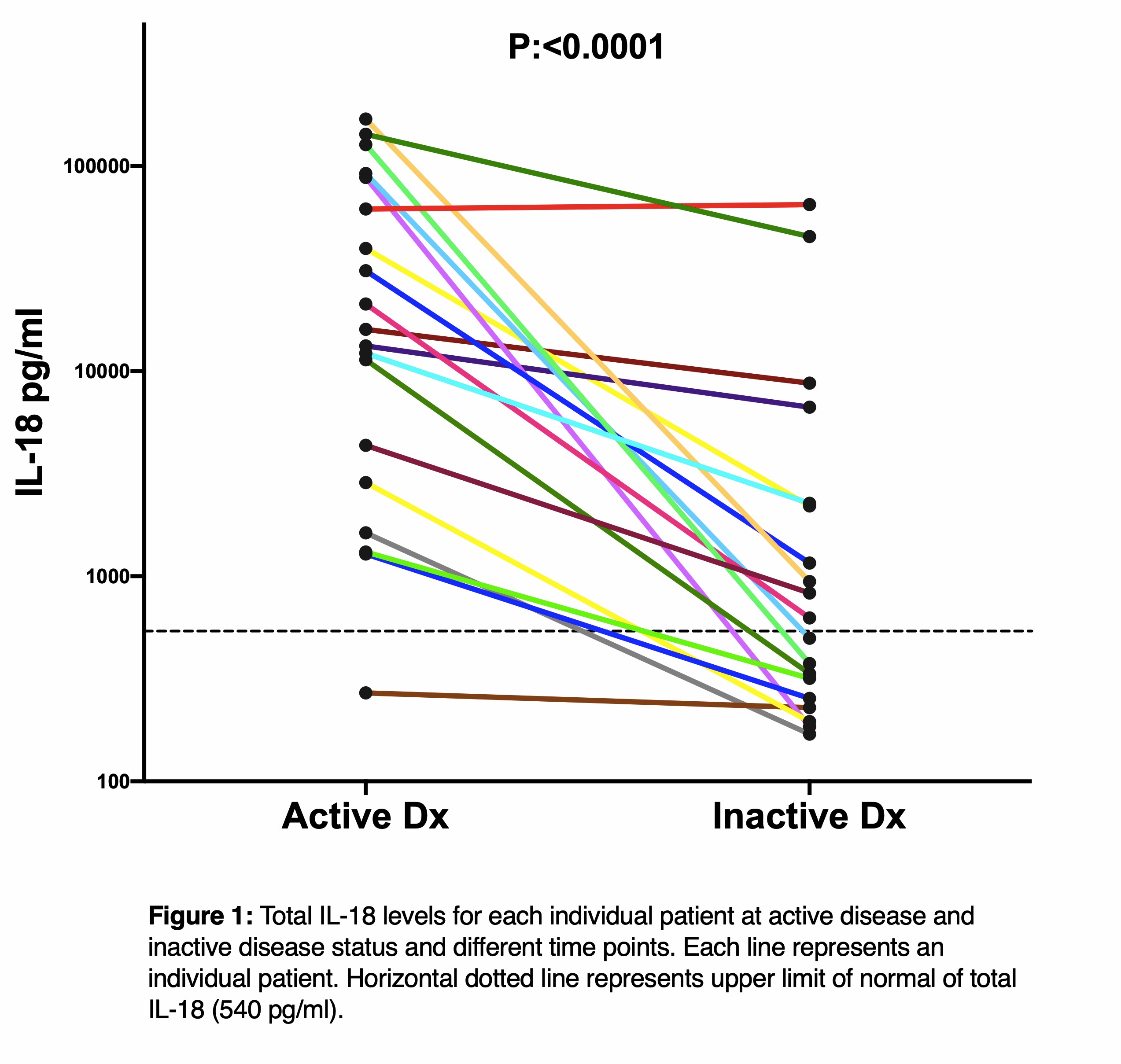Session Information
Date: Sunday, November 8, 2020
Title: Pediatric Rheumatology – Clinical Poster II: Systemic JIA, Autoinflammatory, & Scleroderma
Session Type: Poster Session C
Session Time: 9:00AM-11:00AM
Background/Purpose: Systemic juvenile idiopathic arthritis (sJIA) is a childhood arthritis with prominent innate immune activity. Disease presentation and flares could largely mimic infections with fever being a prominent feature. sJIA is associated with production of inflammatory cytokines including IL-18. IL-18 plays a key role in the pathogenies, with high levels in patients with active disease. To date, there are no specific reliable biomarkers for disease activity in sJIA. IL-18 may be a useful biomarker for diagnosis and more importantly monitoring disease activity and flares. Our objective is to quantify change in serum IL-18 levels in response to change in clinical disease activity in patients with sJIA.
Methods: This is a prospective longitudinal study. Serial serum levels of total IL-18 (pg/ml), CXCL9, and S100 proteins were obtained from 30 sJIA patients aged 1-19 at time of sampling. Clinical data was abstracted from medical records. Levels were compared within and between individual patients with regards to clinical and laboratory features. This study was approved by CCHMC Institutional Review Board, and informed consent was obtained.
Results: IL-18 was significantly higher in active disease (median 13279 pg/ml (IQR: 2496-61638), N=35) in comparison to clinically inactive disease (CID) (median 810 (326.5-4471), N=25). The median difference (12469 pg/ml) was statistically significant (p < 0.0001). IL-18 correlated with S100 A8/9 (r=0.49, p=0.0008) and CXCL9 (r=0.55, p=0.0004) regardless of clinical disease activity.
IL-18 was significantly different between patients with CID, active disease due to arthritis only, active disease due to systemic features only or active disease due to both (p< 0.0001). Post-hoc analysis showed that there is no difference between CID and active disease due to arthritis only (p >0.999). The difference was significant between those with systemic features only or systemic features combined with arthritis compared to CID (p=0.0012 and 0.0002, respectively). Also, IL-18 correlated strongly with systemic manifestation score of systemic JADAS (r=0.67, p< 0.0001).
19 patients had paired samples captured at both CID and active disease status, while 8 had samples at only active disease and 3 only at CID. Median time difference between samples for each patient was 10.5 months. Comparing paired samples, median difference in IL-18 was not significant (455.5 pg/ml, p=0.855). Interestingly however, median decline in IL-18 between paired samples of patients changing status from active to inactive approached 90% (median decrease 9963 pg/ml, p< 0.0001). The difference was minimal (343 pg/ml) and not significant with no status change (p=0.7002). For paired samples with changing disease status, IL-18 performed well with AUC of 84% (p=0.0002).
Conclusion: Capturing within individual changes, IL-18 drops significantly with disease control and decreased clinical disease activity, but change is minimal for those with unchanged activity. IL-18 is significantly higher in patients with systemically active disease. This report raises optimism about the use of IL-18 as a biomarker of disease activity change and to guide initiation, continuation, escalation and cessation of therapy.
To cite this abstract in AMA style:
Yasin S, Do T, Dhakal S, Baker E, Grom A, Schulert G. IL-18: A Biomarker That Reflects Disease Activity, Could It Be the Next Disease Activity Measure in Systemic Juvenile Idiopathic Arthritis? [abstract]. Arthritis Rheumatol. 2020; 72 (suppl 10). https://acrabstracts.org/abstract/il-18-a-biomarker-that-reflects-disease-activity-could-it-be-the-next-disease-activity-measure-in-systemic-juvenile-idiopathic-arthritis/. Accessed .« Back to ACR Convergence 2020
ACR Meeting Abstracts - https://acrabstracts.org/abstract/il-18-a-biomarker-that-reflects-disease-activity-could-it-be-the-next-disease-activity-measure-in-systemic-juvenile-idiopathic-arthritis/

